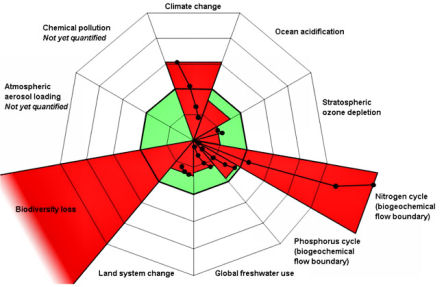That is that there will be a massive die off when the cheap oil runs out. He also believes in euthanasia for the less fortunate.
http://timesonline.typepad.com/environment/2009/11/peak-oil-and-population-control.html
November 04, 2009
Peak oil and population control
Last week I had the miserable experience of interviewing a man who had accidentally survived a suicide pact with his wife.
Dr William Stanton, 79, has bone cancer and is plainly very ill: doctors give him three to eight months. His wife Angela was 74, and in good health, but didn’t want to survive him.
Dr Stanton happens to be one of the foremost proponents of population control in Britain, possibly anywhere, and has written articles and letters for anybody who will publish them, including his local paper and the New Scientist. But the latter stopped publishing him more than 20 years ago because – he believes – his views are regarded as being beyond the pale.
A geologist by profession, Dr Stanton has made a massive study of global population growth since the start of the industrial revolution, and suggests persuasively that the growth can be accounted for precisely by the advent of cheap oil. He contends that global oil production is at peak now, however, and that diminishing supplies will require the population of Britain to fall from around 60m today to just 2m in 2150.
Two million!
This will either happen inadvertently, he argues, as people kill each other for precious resources, or in a controlled way, as laws restrict women to just one child each, humane euthanasia becomes widespread to deal with people who represent a “net drain” on society, and immigration is made illegal – arrivals would be put to work in chain gangs, with other criminals.
In its own terms, Dr Stanton’s analysis makes some sense, but his prescriptions are utterly repellent. But when I said that, he told me I was being sentimental. Was he right?
You can read my Sunday Times interview here. If you wish to find out more about Dr Stanton’s views – and his struggle to get them into the mainstream – you should Google him.
:}
Unfortunately, in the long article of maybe a gazillion words, he mentions Bill Stanton’s beliefs on population in two or three paragraphs focusing most of the rest of the article on Stanton and his wife’s botched double suicide. The irony of his healthy wife dying and he being terminal with cancer and living is over exploited. Also the author spills a lot of ink on Britain’s law against assisted suicide and how 132 Britains went to Switzerland to do the deed.
http://www.timesonline.co.uk/tol/news/uk/article6897964.ece
November 1, 2009
William Stanton: I botched our suicide pact
William Stanton and his wife tried to end their lives together – but they only half succeeded. He says He’d do it again

Early one morning in September, William Stanton heard footsteps coming up the stairs of his cottage in Somerset. He knew who it was and panicked. “I shouted out: ‘Go away, Nigel, leave me to it, leave me to it!’”
Nigel, a neighbour and family friend, did not go away. He came into the bedroom and found Stanton in distress and his wife Angela lying dead with a plastic bag over her head.
The Stantons had made a pact to end their lives together and put it into effect just days after the director of public prosecutions revealed how he would apply the law prohibiting assisted suicide. It did not work out as they planned and stands as a terrible cautionary example for anybody thinking that self-inflicted death is easily arranged.
I met Stanton last week in the neat and pretty bedroom where Angela’s body was found. I noted a commode in the corner and a trolley-load of pills beside Stanton, who was sitting up in bed. He is 79 and obviously unwell — his doctors say bone cancer will kill him in three to eight months — but he complained only that the pills make him lethargic.
:}
For a better exposition you might look here:
http://billtotten.blogspot.com/2005/07/oil-and-people.html
Association for the Study of Peak Oil & Gas, Ireland
ASPO Newsletters, Article Number 573 (July 2005)
The population of the World expanded six-fold in parallel with oil production during the First Half of the Age of Oil. William Stanton, author of The Rapid Growth of Human Population 1750-2000 (Multi-Science Publishing, 2003) contributes the following analysis of how population will have to return to pre-Oil Age levels. Let us hope that it does not come to this, but the options explained do have a certain chilling logic.
Reducing Population in Step with Oil Depletion
by William Stanton
Recent articles in the ASPO Newsletter have agreed that the explosion of world population from about 0.6 billion in 1750 to 6.4 billion today was initiated and sustained by the shift from renewable energy to fossil fuel energy in the Industrial Revolution. There is agreement that the progressive exhaustion of fossil fuel reserves will reverse the process, though there is uncertainty as to what a sustainable global population would be.
In this time of energy abundance, and the complacency it engenders, the vast majority of the general public assumes that what the future holds is “more of the same”. They argue, if pushed, that the expertise inherited by post-fossil-fuel scientists and engineers will allow a smooth transition into a new kind of energy-rich world in which renewable generators will produce as much energy as fossil fuels do now. Such a view is untenable because it ignores the fact that almost all materials essential to modern civilization will be orders of magnitude more costly, and scarce, when they have to be produced using renewable energy instead of fossil fuels.
:}
Or more to the point read the original:
http://www.relocalize.net/files/Futures%20proof.pdf
By the By, if he is right there would only be 12 million people left in America. Best estimates for Native American populations the were 21 million..
:}





















